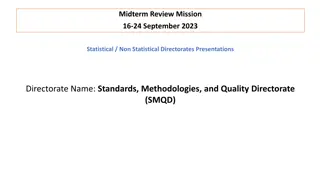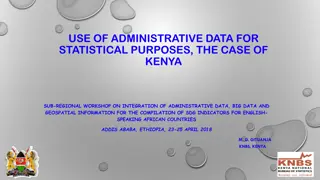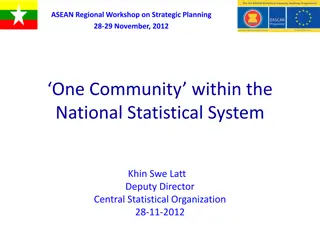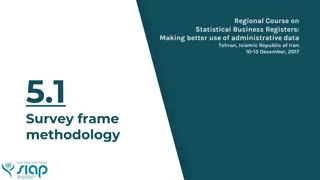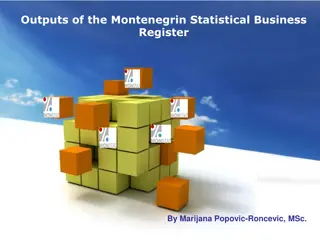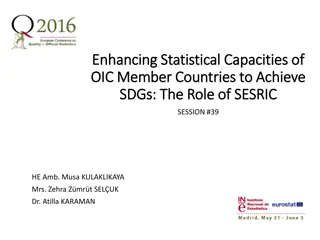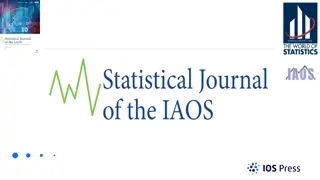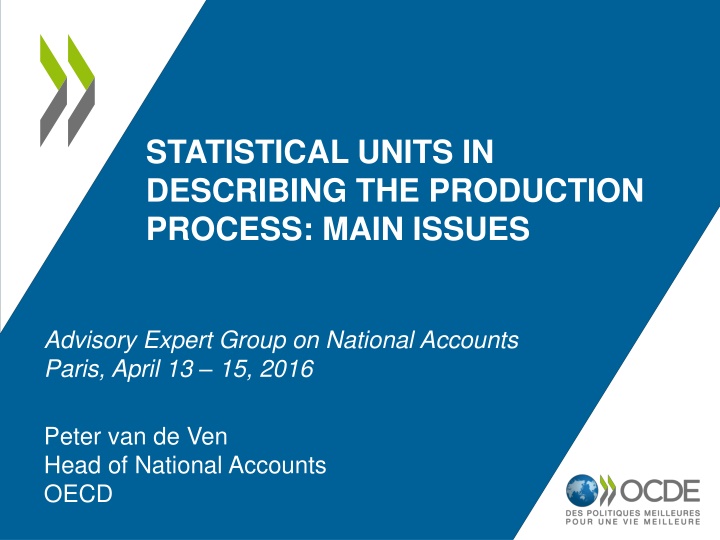
Statistical Units in Describing Production Process: Key Considerations
Explore the main issues in using statistical units to describe the production process based on discussions at the Advisory Expert Group on National Accounts. Learn about the importance of establishments as statistical units and the focus on refining international standards. Discover the significance of production functions and the goals of the International Task Force for Statistical Units.
Download Presentation

Please find below an Image/Link to download the presentation.
The content on the website is provided AS IS for your information and personal use only. It may not be sold, licensed, or shared on other websites without obtaining consent from the author. If you encounter any issues during the download, it is possible that the publisher has removed the file from their server.
You are allowed to download the files provided on this website for personal or commercial use, subject to the condition that they are used lawfully. All files are the property of their respective owners.
The content on the website is provided AS IS for your information and personal use only. It may not be sold, licensed, or shared on other websites without obtaining consent from the author.
E N D
Presentation Transcript
STATISTICAL UNITS IN DESCRIBING THE PRODUCTION PROCESS: MAIN ISSUES Advisory Expert Group on National Accounts Paris, April 13 15, 2016 Peter van de Ven Head of National Accounts OECD
Introduction SNA 2008 distinguishes two different types of statistical units: Establishment for the description of the production process in supply and use framework Institutional units for the description of income and finance in institutional sector accounts Today: focus on the statistical unit for the description of the production process although some of the considerations are interrelated Main goal: to provide further guidance to the International Task Force on statistical units, to get a better idea of important considerations 2
International Task Force Terms of Reference for the establishment of an International Task Force on Statistical Units has been agreed, with the following main objectives: To (re)consider the current 2008 SNA recommendations, and if need for change, to come up with concrete and implementable proposals To come with concrete suggestions, e.g. regarding the criteria for distinguishing separate units, to arrive at internationally comparable implementation To come with concrete proposals for classifications by industry and institutional sector To asses the potential quantitative impact of proposals Task Force still needs to be established 3
Production functions Abstract description of the technological process How enterprises (or parts thereof) use: inputs of labour, capital (both tangible and intangible), and intermediate consumption to produce outputs of goods and services In terms of aggregating units, economists prefer to group units with similar production functions together Much of this preference is linked to productivity analysis and analysis of technological change 4
Why are establishments the preferred unit in the SNA 2008? The premise in the SNA is that the establishment is the ideal unit Establishment are the units with the greatest homogeneity in terms of output, which are also statistically observable Thus also being the units designed to provide data that are more suitable for analyses of production However, when this preference was developed: More likely to be the only site for the entire enterprise More likely to keep their records in such a way that data could be collected Deemed the best way to maintain the link between inputs and outputs at a detailed industrial level as well as having a geographical link to produce regional statistics 5
Data needed for description of production process The items included in the production account and the generation of income account: Must be feasible to calculate output, intermediate consumption and thus value added and also compensation of employees, taxes on production and imports, subsidies and the operating surplus or mixed income Statistics of numbers of employees, types of employees and hours worked Changes in inventories and gross fixed capital formation, including stocks of non-financial assets used in production 6
Feasibility of data at the establishment level: theoretical considerations In the case of multi-establishment enterprises: Establishments may not be the appropriate unit because not the decision unit Essential inputs cannot be allocated uniquely to establishments Capital services related to intellectual property products (e.g., R&D, software, and databases) Business services (corporate and/or ancillary services provided or purchased at a centralised level of the enterprise) Not possible to appropriately account for the operating surplus at the establishment level (absence of market prices and issues related to inter-establishment transactions) 7
Feasibility of data at the establishment level: practical considerations Changes in collection of source data: Pressure to decrease respondent burden More and more use of administrative data Administrative records typically do not relate to establishments but to enterprises or legal units More general shift from surveying at establishment level to surveying at enterprise level Increasingly difficult for enterprises to provide data at establishment level Quality concerns about data collected at establishment level, because not readily available 8
Issues to consider: regional accounts Multi-regional enterprises create problems with allocating economic activities to regions => need for data at local level (i.e. establishments) However, the main issues related to the compilation of data by industry at the establishment level are also relevant for regional accounts: allocation of capital services, corporate services, operating surplus, etc. Does establishment level data actually add to the quality of regional data, over and above data on employment and compensation of employees? What is actually needed: only certain indicators like value added and employment, or a full-fledged regional supply-use table? 9
Issues to consider: homogeneity SNA s preference reflected the view that establishments classified to the same industrial classification shared similar characteristics, and were considered relatively homogeneous Underlying assumption seems to have weakened: Growing share of output generated by foreign affiliates, outsourcing, new types of producers Under current industrial classification, contractors are classified to the same category as units producing for their own account, foreign controlled and domestically controlled units are grouped together Much more rapidly changing products, production functions and organisational arrangements, thus putting into question consistency over time 10
Issues to consider: derivation of symmetric input-output (IO) tables Usually, description of production process starts with balancing supply and demand of goods and services within a supply and use framework (SUT) From a purely statistical point of view, SUT are perfectly equipped to deal with heterogeneity For certain types of analysis, one would need symmetric input-output tables => more heterogeneous SUT require additional assumptions, to allocate intermediate consumption and labour inputs to primary and secondary outputs Note: often industry-by-industry input-output tables; see also following consideration 11
Issues to consider: change of emphasis in production process Less clear whether establishments need to be the preferred unit More emphasis on economic view, instead of physical production processes Move from product-by-product matrices to industry- by-industry Other, more economic breakdowns may be more preferable for today s economy, e.g. based on ownership criteria (public corporations, foreign controlled corporations, other private enterprises), or types of producers (e.g. distinguishing contractors from other enterprises) 12
Issues to consider: integrated analysis Increasingly important to link the real economy and the financial economy (e.g. financial crisis, impact of holding gains, trade in value added) Using the same statistical unit in the SUT and institutional sector accounts would allow for better integration, and combined monitoring and analysis of production, income, and finance This would disqualify establishment, as most of the information needed to compile institutional sector accounts is not available at the establishment level 13
Issues to consider: linking data Increasing demands for detailed analysis in which, for example, production statistics need to be linked to statistics on enterprise characteristics, foreign (affiliate) trade, employment, etc. Use of establishment makes it difficult to properly link the data as these phenomena are typically only available at the enterprise level More generally: potential for micro-macro linking 14
Issues to consider: efficiency and flexibility Removing the preference for establishments Provides a better link to corporates own business accounting frameworks Reduce reporting burden for respondents Reduce statistical burden for national statistical offices Creates more opportunities for linking data, thus increasing flexibility of statistical system 15
Questions for the AEG Are these the most important issues for the discussion on the choice of statistical unit? Are there additional considerations which may need to be taken into account? In your opinion, how important are the various considerations? 16

